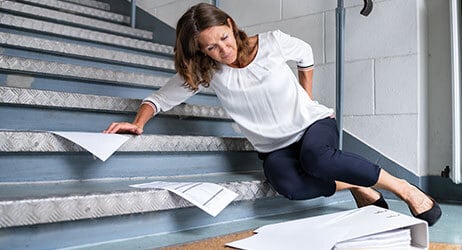Slips and falls at work happen more frequently than you may imagine. These accidents, whether they include a wet floor, a congested walkway, or a slippery surface, can cause serious injuries that influence your health and capacity to function. One of the most important questions to ask when you slip and fall at work is: Who is responsible for your injuries?
Understanding Slip and Fall Incidents
Accidents involving slips and falls can happen anywhere there is a workplace, including office buildings and construction sites. These mishaps often occur when someone loses their balance because of a dangerous situation on the property, like:
-Slick or wet floors
-Damaged or uneven flooring
-Unorganized walkways
-Bad lighting
-Inadequate hazard warning signs
It’s critical for both employees and employers to comprehend culpability in workplace slip-and-fall incidents. It promotes companies to maintain a safe workplace and ensures that injured workers receive compensation for their injuries. In this blog, we’ll examine the crucial elements that establish culpability in slip-and-fall accidents at work.
-
Responsibility of the Employer
The law requires employers to give their workers a safe workplace. This duty of care includes several responsibilities, such as keeping the workplace risk-free, routinely scanning the area for any hazards, and acting quickly to address any harmful situations. Employers may be held accountable for employee injuries if they breach these duties and an employee slip and falls as a result.
-
Negligence:
The injured worker typically needs to demonstrate that the employer’s negligence had a major impact on the slip and fall incidence to establish culpability. It is implied by the term “negligence” that the employer did not take reasonable precautions to avoid accidents.
Frequently, proving carelessness requires proving that:
– The hazardous condition was known to or should have been known to the employer.
– The employer failed to address the issue appropriately or issue sufficient warnings.
– The employee fell and suffered injuries as a direct result of the dangerous state.
-
Comparison of Negligence
It’s crucial to remember that responsibility may not always lie with the employer. In some circumstances, the accident may have also been caused by the wounded employee’s actions or negligence. The idea of comparative carelessness is applicable in this situation.
Due to the possibility of both the employer and the employee having contributed to the incident, comparative negligence allows for a reduction in the number of damages that will be paid out. A worker’s own fault can lessen the employer’s liability, for instance, if they were texting on their phone while ignoring a “wet floor” notice.
-
Liability to a Third Party:
In rare cases, a third party, such as a contractor or vendor, may be held accountable for establishing the hazardous condition that caused the slip and fall or for failing to fix it. In such circumstances, in addition to any prospective claim against their employer, the wounded employee may have a legal claim against that third person.
-
Compensation for Workers:
Workers’ compensation insurance is intended to offer benefits to employees who sustain work-related injuries in various nations, including the US. Regardless of who was at blame for the accident, workers’ compensation normally pays for medical bills and a portion of the employee’s lost wages. Employees typically give up the right to sue their employer for carelessness in return for these perks. This “no-fault” system aims to give injured workers a quick means to get compensation without the need for protracted legal disputes.
-
Legal Options:
There are procedures you can take to pursue damages for your injuries if you slip and fall at work and think your employer’s negligence was to fault. These actions could involve:
– Informing your employer about the situation and making sure it is recorded.
– Seeking emergency medical care and documenting all medical care linked to the injury.
– Speak with a personal injury lawyer who focuses on workplace accidents to determine the viability of your claim.
– If required, pursue a personal injury lawsuit against a negligent third party or make a workers’ compensation claim.
In conclusion, depending on the circumstances, liability for your injuries if you slip and fall at work may lie with your employer, a third party, or even with you to some extent. It’s crucial to be aware of your rights and legal alternatives in such circumstances, emphasize workplace safety, and endeavor to avoid accidents altogether. If you find yourself in this regrettable circumstance, getting legal counsel and taking the necessary measures will help you get the compensation you are entitled to and guarantee that future occurrences of this kind are prevented. Call now for a free consultation (718) 414-6642.


 Slipped at workplace? Find out who is responsible for your Injuries?
Slipped at workplace? Find out who is responsible for your Injuries? 

